Most tourists have an impression that Borneo is a tropical island full of coconut trees. As a matter of fact, in only 10 sq. KM of Borneo rainforest, there are more flora than that of North America and Europe combined. Without rich diversity of tree species as a food source and habitat, our most charismatic wildlife such as orangutan would not survive.
Our trees are not boring. Let’s look at 10 of them. You would be surprised that most of them are closely related to your life.
1. Belian, the Ironman tree
Locally known as Belian, Borneo’s ironwood (Species: Eusideroxylon zwageri, Eusideroxylon means sinking wood) is the heaviest, hardest and most valuable timber of Borneo. Belian can live over 1,000 years and it grows extremely slow (mean radial rate of 0.058cm per year), reaching only a diameter of 30cm even after 120 years. That’s why it is so hard and dense that it doesn’t float on water and termites can’t bite through.
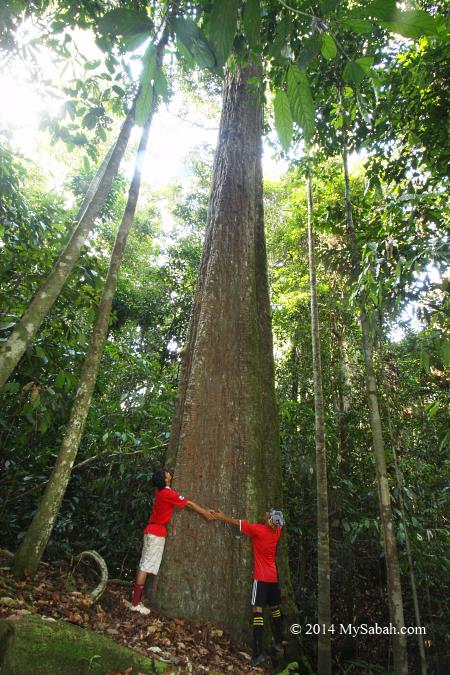
Pic: hundreds year old Belian in Imbak Canyon
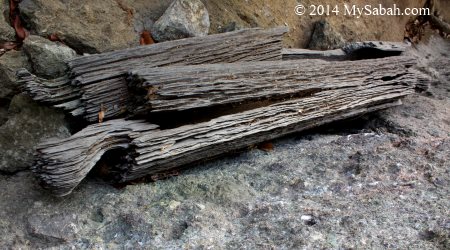
Pic: 200-year-old Belian coffin in Danum Valley
However, this hardwood can’t fight chainsaw and millions of them are fallen by greedy loggers who see it as a standing gold bar. Now only a small number of Belian trees live in most remote forest of Borneo. Belian is so strong and resistant to decay that it can last 200 years in worst condition, so it’s the best wood for jetty, dock and piling. In history, China emperor used it as the pillars of Forbidden City, Murut (Borneo headhunter) used it to make blowpipe, Dusun ancestors used it to create coffin.
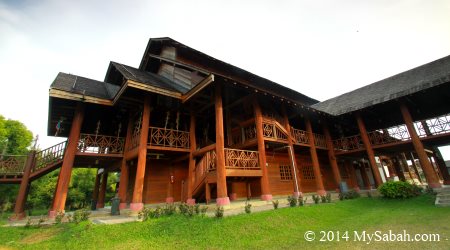
Pic: Murut Cultural Center supported by Belian wood pillars
2. Tongkat Ali, the Viagra tree
Ask any Malaysian what is Tongkat Ali (Eurycoma longifoliam) and note the sheepish smile on their faces. Tongkat Ali is viewed as Malaysian Ginseng and has been used as a traditional aphrodisiac. You can buy Tongkat Ali readily for cheap price at local markets and even tourist souvenir shops (it’s a hot selling item, from what I heard).
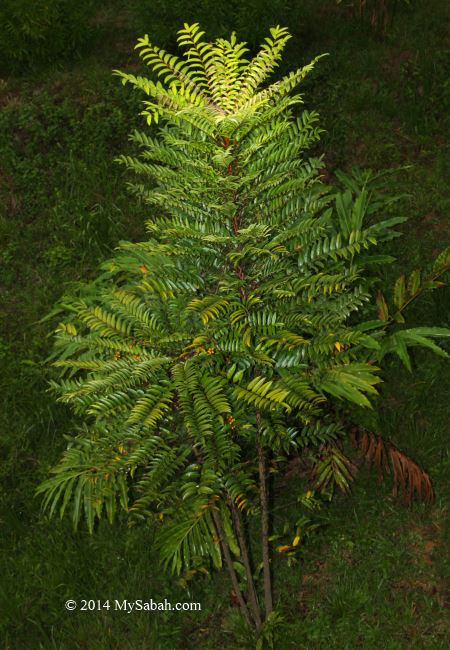
Pic: Tongkat Ali tree
Literally Tongkat Ali means “Ali’s Walking Stick.” It can grow up to 5m tall and 20cm in diameter and prefers well-drained forest slopes under partial shade. It looks like a small tree but what under its stem is long and fat root. To harvest its root, you need to tie its stem with a rope then have two men to pull it out of the soil. Tongkat Ali has two types, one with white root, which is more common and tastes really bitten, another is black color, which is better but rarer.
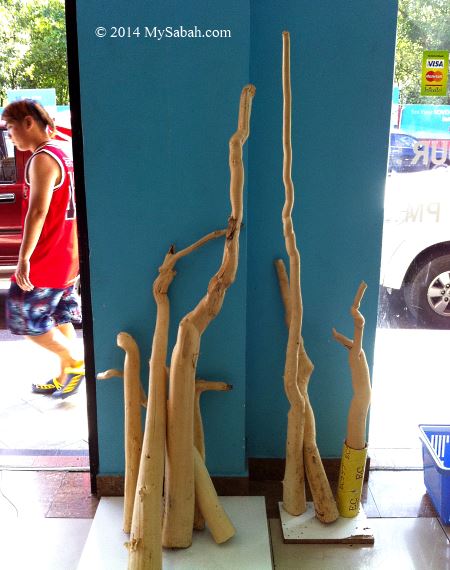
Pic: roots of Tongkat Ali
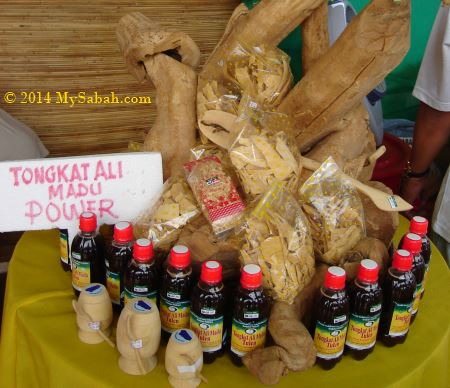
The root of Tongkat Ali has sexually-enhancing and testosterone-raising effect (its leaves can relieve stomach pain). The decoction of the pounded and boiled root is a popular drink to improve the potency of men hence a happy sex life. Now you even can find Tongkat Ali Coffee on the market (a few friends told me it really makes them “hard”). Hey, why bother about the expensive blue pill?
3. Strangling Fig, the tree Killer
Ever heard of a tree strangles another tree to death? This is not a fiction. The tragedy starts from a seed of strangling fig (Ficus spp) being carried in the poo of fruit-eating animals such as bird and squirrel to the treetop.
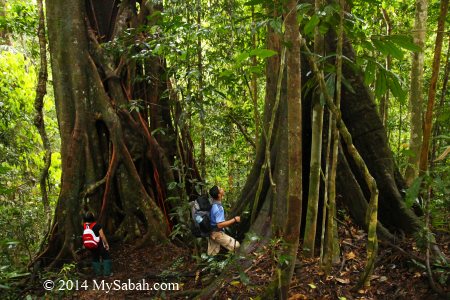
Pic: huge strangling fig trees in Maliau Basin
The seed germinates on the big tree and sucks nutrients out of it. Over time, this parasitic tree slowly spreads its branches from the crown of the host tree to the ground, the roots joined when meet, forming a basketwork of interlacing roots around the trunk. Strangling fig tree will grow faster once its roots reach the soil for more nutrients, the roots thicken and constrict the flow of nutrients of its host, eventually the host tree dies.
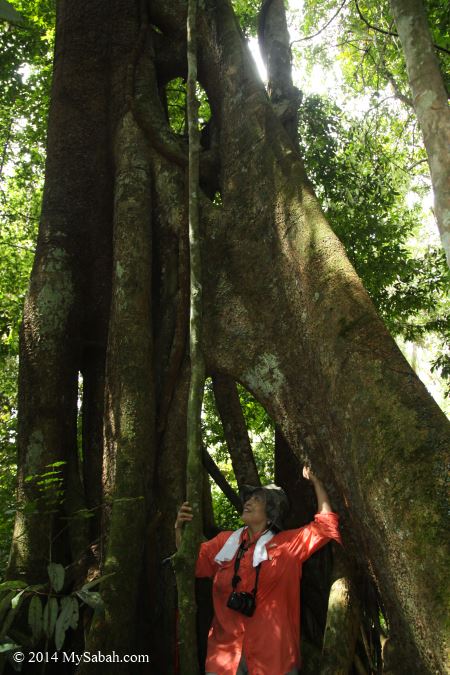
Pic: hollow left by the decayed host tree
The murder takes many years to happen. At the end, strangling fig wins, flowers and its fruits will attract another seed-carrier which poo on the next victim. Thing gets more interesting after the dead tree decomposes, as it will leave a hollow inside the new tree. Strangling fig sounds evil, but its fruit is an important food source for wildlife. Btw, be careful when a bird poo on your head lol.
4. Menggaris, the Honey Bee tree
In the Borneo jungle, even the most casual hiker would not miss the towering Menggaris tree (Koompasia excelsa), a member of the bean family. Menggaris (or Mengaris) is a beautiful, tall, and straight tree that can easily exceed 60m in height and grows up to 88m, one of the tallest tree species in the Borneo rainforest.
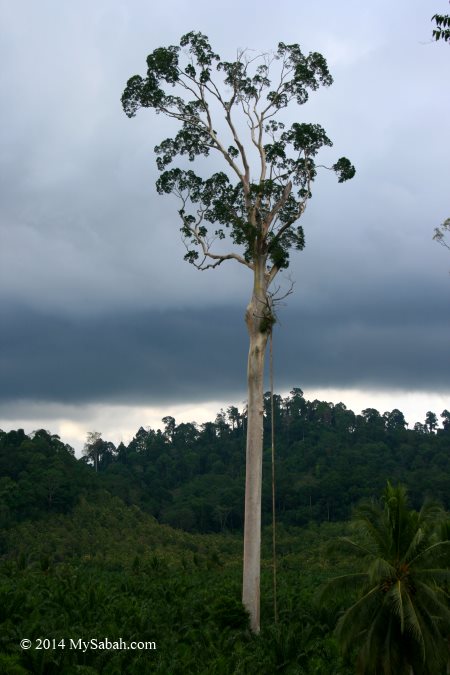
Its cylindrical bole with grey and smooth bark poses a big challenge to excellent climbers such as sunbear and orangutan. Therefore, Menggaris naturally becomes the favorite nesting tree of wild honey bees (Apis dorsata), to keep their honey out of reach of the sunbear, the honey lover. It is common to see over 10 bee hives under the branches of same Menggaris tree.
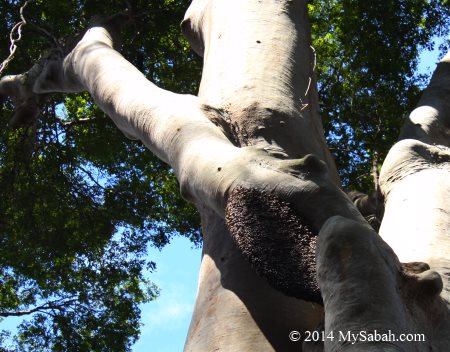
Pic: bee nest on Menggaris tree
Luckily, because of its hollow trunk, Menggaris is not a good timber, so you can see them remain standing on a deforested land. Villagers will build climbing aid on Menggaris tree to harvest its honey. Got honey got money. Menggaris is also considered as a sacred tree in Dayak folklore of Sarawak.
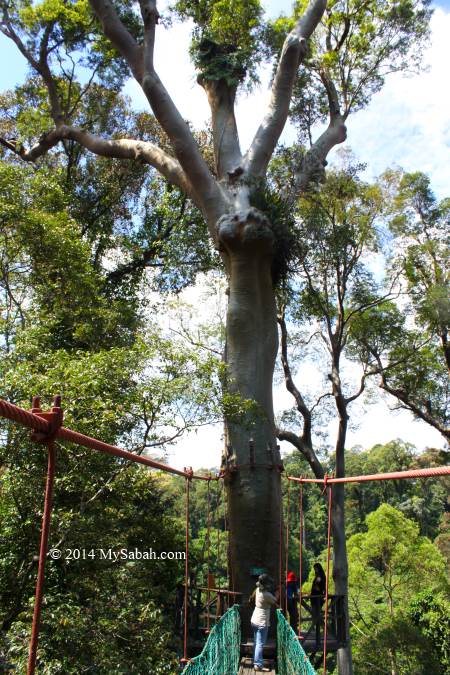
Pic: canopy walk allows you to see Menggaris up-close
In southern Sabah, the Menggaris tree is revered as the home of spirits. Even during land clearing for settlements or oil palm, locals refuse to cut it down, leaving tall Menggaris trees standing alone amid the plantations.
5. Gaharu, the Perfume tree
Gaharu (Aquilareia malaccensis) is also known as agarwood, incense wood, and aloes wood. This intensely fragrant resinous wood is widely used in religions (some even call it the “Wood of the Gods”), probably because it resembles the smell of heaven, so its price is sky high too, at least US$1,000 per Kg. There have been local and foreign thieves who trespass on our protected forest to collect agarwood illegally.
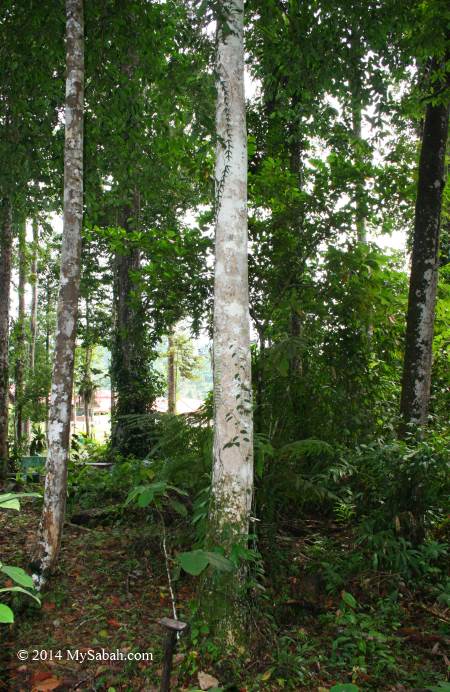
Pic: Gaharu tree in Tawau Hills Park
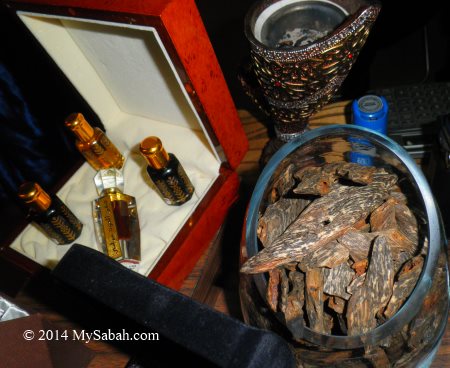
Pic: agarwood products for sale
Normally, the wood of the Gaharu tree is white and has no odor. But if the tree is infected by fungus, it’ll produce dark aromatic resin to protect itself. This agarwood is not only highly prized as an incense, but it is also an important ingredient for the perfume industry. Some farmers include gaharu as one of the crops in their integrated farming.
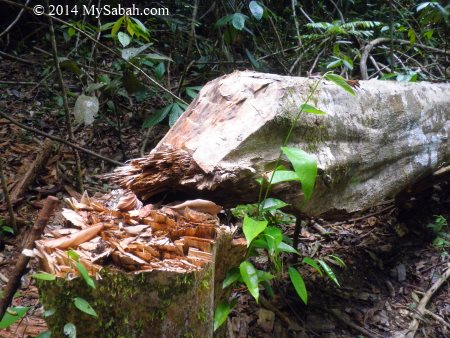
Pic: Gaharu tree cut by thief
6. Mangrove, the Summer Xmas Tree
Growing in smelly and muddy swamp land, how can mangrove trees (Rhizophora spp) be interesting? In the old days, mangrove forest was considered wastelands full of mosquitoes, and people weren’t hesitant to clear them. Now we know that the mangrove ecosystem serves an important role in flood mitigation, the prevention of coastal erosion, and as a feeding ground for migratory birds.
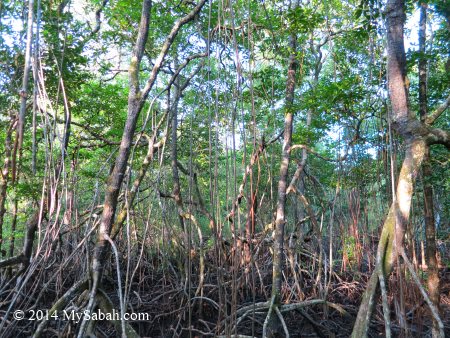
Pic: note the breathing roots of mangrove trees
Sabah occupies 59% of total mangrove area in Malaysia. Mangrove is the nursery of seafood and that explains why Sabah is abundant in seafood. Mangrove is also the habitat of Proboscis Monkey, our endemic Borneo monkey which attracts a lot of tourist$. At night, hundreds of firefly congregate and twinkle on mangrove, turning the tree into a Summer Xmas tree. Nowadays, the well-being of our seafood and tourism industries depend heavily on healthy mangrove.
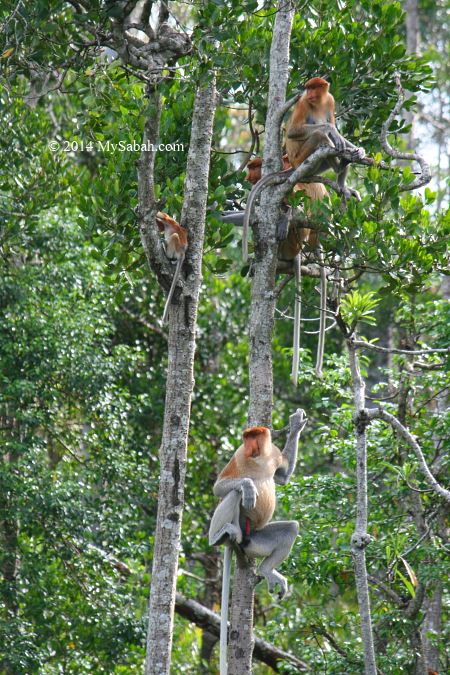
Pic: proboscis monkey family on mangrove tree
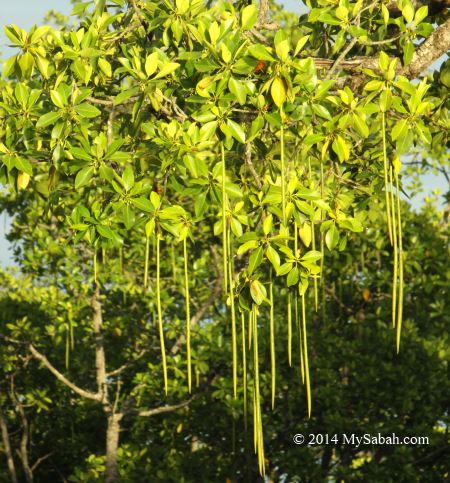
Pic: vivipary, the spear-shaped seed of mangrove
Living in a tidal zone, mangrove tree develops many interesting features to adapt to this harsh environment. It uses stilt roots to breathe and hold itself firm in the mud. Its torpedo-shaped seed (vivipary) may look peculiar, but it helps the seedling to anchor in the soft substrate when detached from the mother tree.
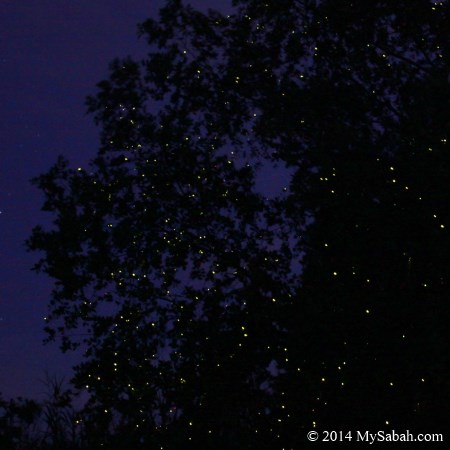
Pic: firefly Summer Xmas Tree in Klias Wetland
I would say the mangrove tree is the most useful tree because it benefits all of us.
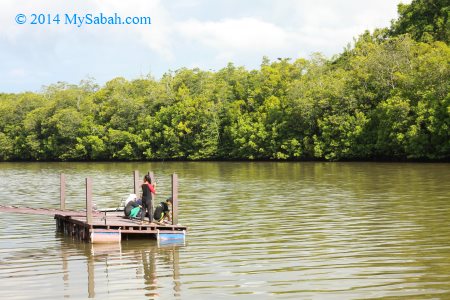
Pic: river of mangrove is always a good spot for fishing (watch out for crocodile though)
7. Oil Palm, the Money tree
Well, oil palm (Elaeis guineensis) is not so “Borneo”, but this native species of West Africa has blanketed nearly 20% of Sabah, the largest palm oil-producing state in Malaysia. Now, oil palm is a cash crop, so it is quickly turning swaying coconut and banana trees of the countryside into ugly palms. Palm oil also enters every corner of our lives, from soap, shampoo, cooking oil, chocolate, margarine, cosmetics, detergents, and biofuel.

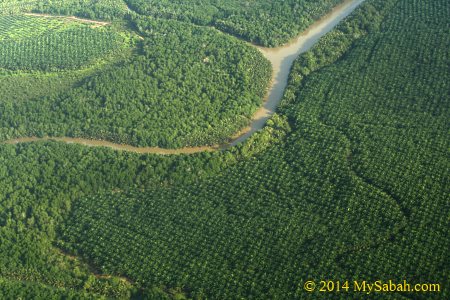
Pic: forest engulfed by oil palm
To be fair, the yield of oil palm per hectare is 10 times more than soybean and sunflower. The crop itself doesn’t cause any problem, only the way it is planted is earning it a bad name among environmentalists, for example, open burning, deforestation, hill clearing, and encroachment into riparian reserves. Anyway, now the government, NGOs, and plantation owners are willing to work together to ensure sustainable and environmentally-friendly practices are in place for this crop.
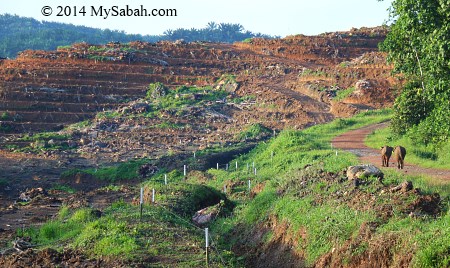
Pic: elephants (right) roaming near a deforested hill
8. Sago Palm, the Edible tree
You may start imagining that you are ordering a piece of wood off a restaurant menu and then biting it like a white ant, or a starving man chewing tree bark. Sago palm (Metroxylon rumphii & Metroxylon sagu) is really edible, but you have to process its trunk first.
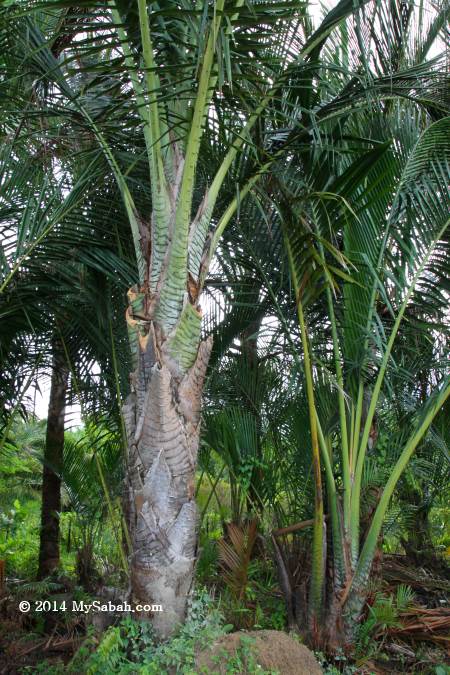
Pic: the pure carbohydrate from sago palm saved many lives in WW2. Sago Palm is also called The Tree of a Thousand Uses. You can use its leaves to make handicrafts and a roof, and its trunk to build houses, etc.
Sago is one of the staple food for people living in south-west of Sabah (Kuala Penyu and Beaufort) and they even celebrate Sago Festival annually. To extract the starch of sago palm, they pound the soft kernel of the trunk into chips, wash the pulverized pith with water, collect the starch and dry it. Sago can be made into different delicious food such as cake and pudding, and the traditional way to enjoy it is to make Ambuyat, a translucent and sticky sago paste, which is served with fish and sour soup.
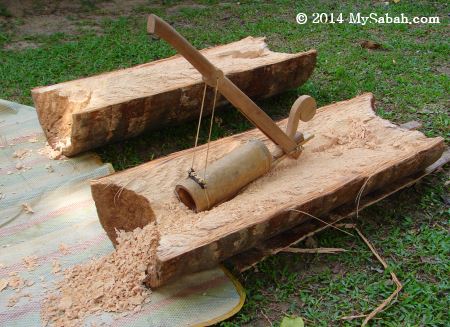
Pic: the traditional tool of sago processing. Now it’s replaced by a machine.
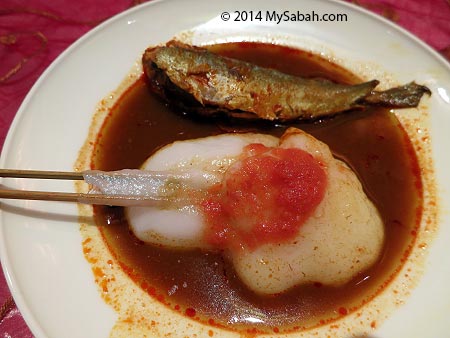
Pic: Ambuyat.. yummy..
During sago processing, the farmers also pick up some wiggling fat larvae of the beetle (Butod), which are well-fed on the kernel. Some locals consider this juicy butod a delicacy and love to eat it alive. Are you keen to try?
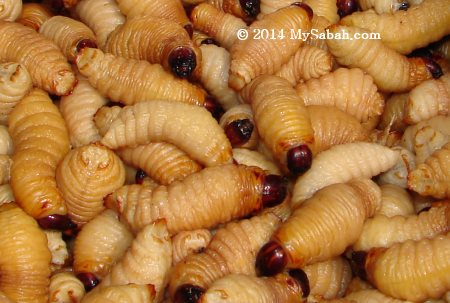
9. Pelawan, a Naked tree
There is a Chinese proverb that says, “Man needs face as much as a tree needs bark”, so I was surprised to see the Pelawan tree (Tristaniopsis spp), which is a member of the Myrtaceae and quite common in the lower montane forest of the Sabah highland.
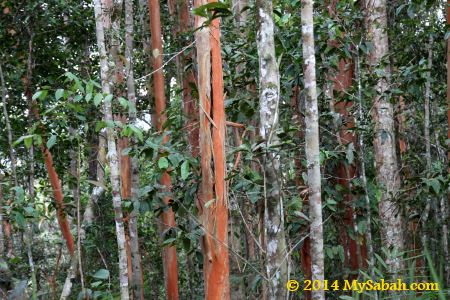
About 20 species of Pelawan are found in Borneo, and these bizarre trees are characterized by flaky orange bark. The tree is so beautiful that a story says other trees were so jealous of its fashionable peeling bark that they beat it with branches.
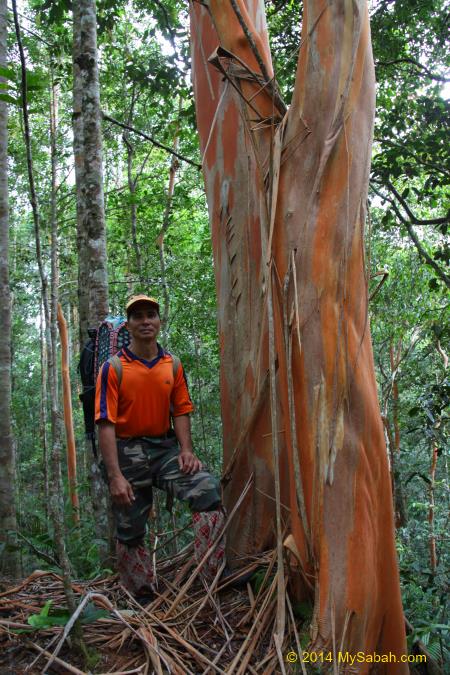
Pic: Tristaniopsis tree in Long Pasia
This phenomenon is just a growing process of Pelawan; the old bark peels off when the fresh bark emerges.
10. Kerosene tree with Petroleum Nut
If your tour guide brings you to the Botanical Garden of Kinabalu Park, he will definitely show you a cool trick by igniting the fruit of the Kerosene tree (Pittosporum resiniferum) like a candle. Yes, the fruit of Kerosene tree is inflammable and can be used in producing biofuel. This tree is less than 10m tall and grows between 400m and 2,300m above sea level. In the old days, locals used the oil of this fruit for lamps.

Pic: fruits of Kerosene tree (Source: Dick Culbert)
Some birds eat this fruit, but it is unclear that if it can help the birds to achieve sonic speed in flight. Just kidding.
The list doesn’t end here. Borneo also has the Tallest Tropical Tree in the World. Please share with me in the comment section below, if you know other interesting trees of Borneo.
Photos taken Sabah, Malaysia Borneo
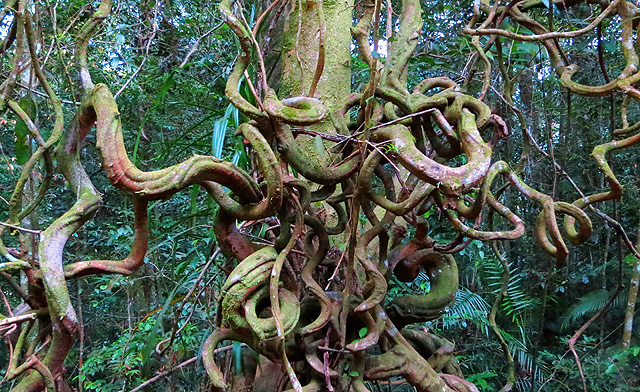

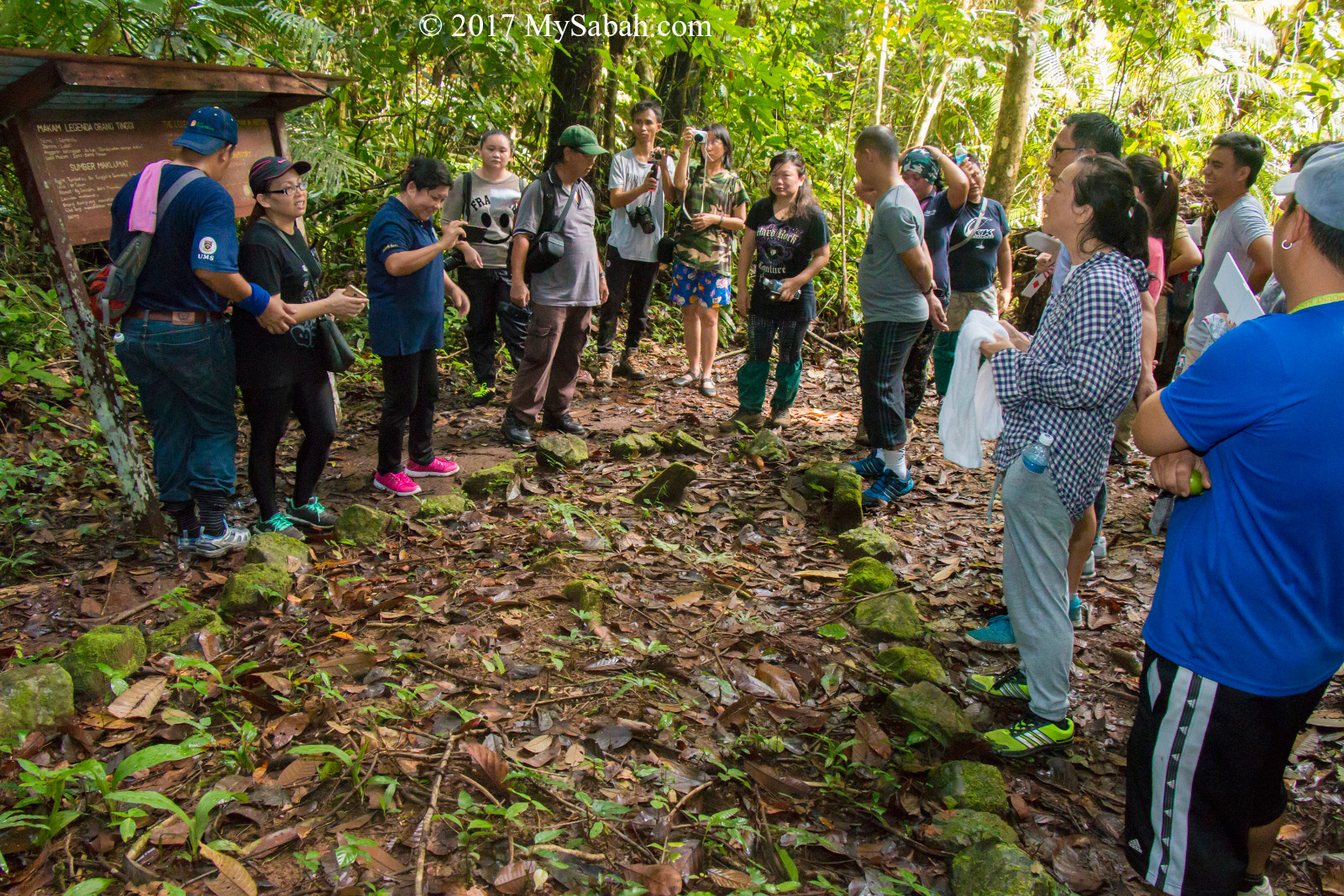
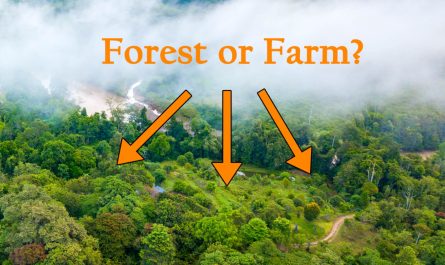

Awesome post. Never knew we had so many interesting and beneficial tress. Hehe.
Butod! I had a pet butod when I was a kid. Brought it to school. lol. But never eaten it raw nor cooked. 😛
Haha, really? I was used to keep frog and sparrow as pet too. One time the frog escaped during class and everyone including the teacher helped me to catch it. 😀 Did your butod survive and grow into a beetle?
Wow frog and sparrow. I had a tortoise too, my friends and I. But one of my friend lost it in class, we suspect someone stole it lol.
Unfortunately, my butod died before the transformation. I didn’t have the proper place for it to grow. Should’ve got an aquarium for him and put him inside. or something. Well, I wasn’t good with that kind of pets. I love cats though. And I had them since I can remember hehe.
Have you eaten the butod before?
I only tried the cooked butod once in Kuala Penyu. It tastes like coconut milk, not too bad, but its skin turns tough after being cooked. I don’t have the courage to swallow butod alive, it’s already too unbearable to imagine its gut “explodes” in my mouth lol. Anyway, I’m keen to try larvae of honey bee. They says it tastes better. 🙂
I have always wondered , where would we get seedlings or saplings for rainforest trees to be planted on deforested areas? Nowadays these invasive acasia trees are the ones over running the jungles.
You can get the seedling from Sabah Forestry Department. They have nursery for inventory of different rainforest species.
A long time ago when visiting Borneo, a Batek told me that the leaves of a certain tree were used as diaper wipes and for washing women’s faces. Another tree–with orange blossoms–was a sign that fish would be nearby. Have you heard of this? Would you know the names of these trees? Thank you!
No, I didn’t hear of this, but I will try to find out. Thanks for sharing.